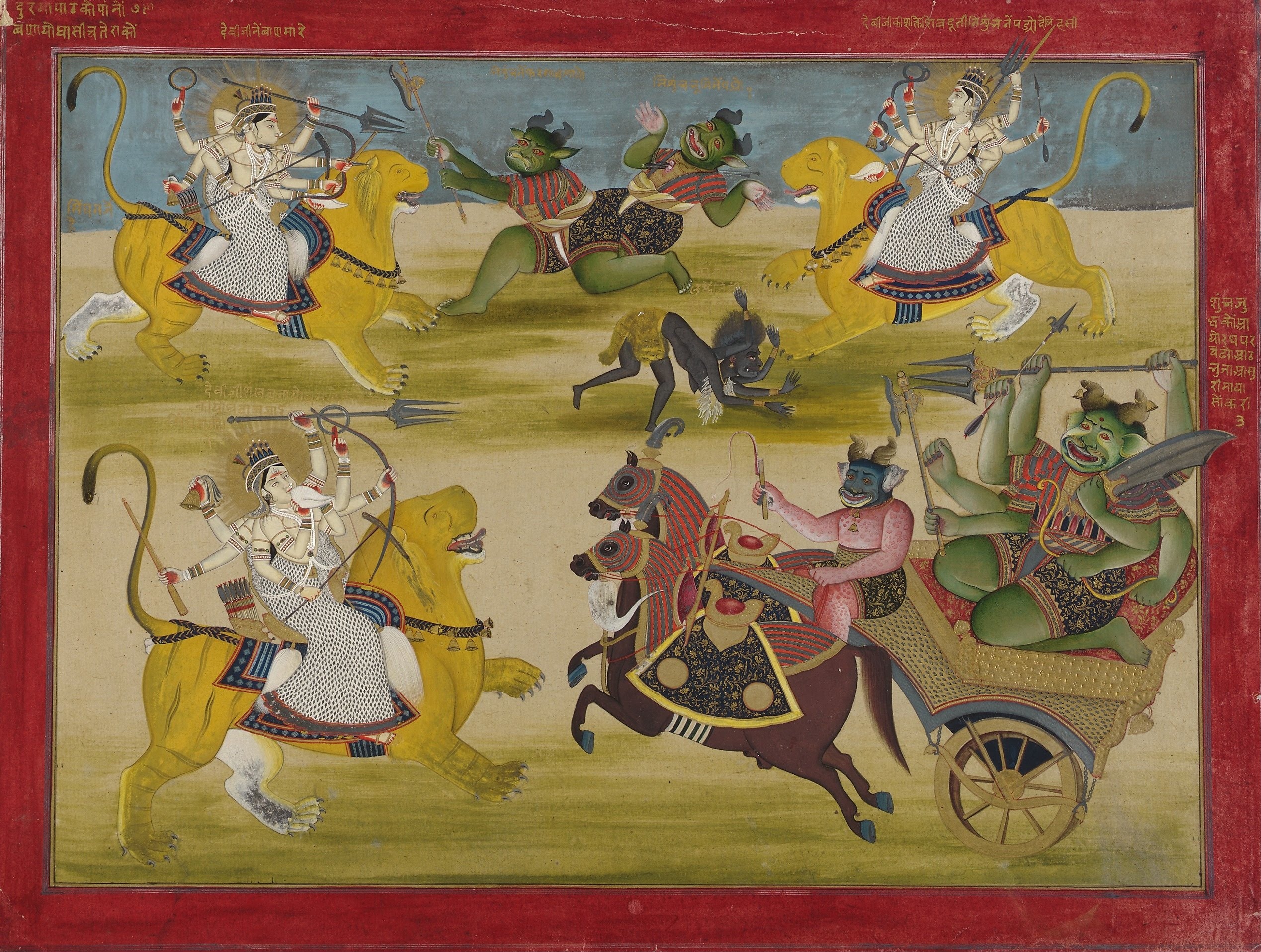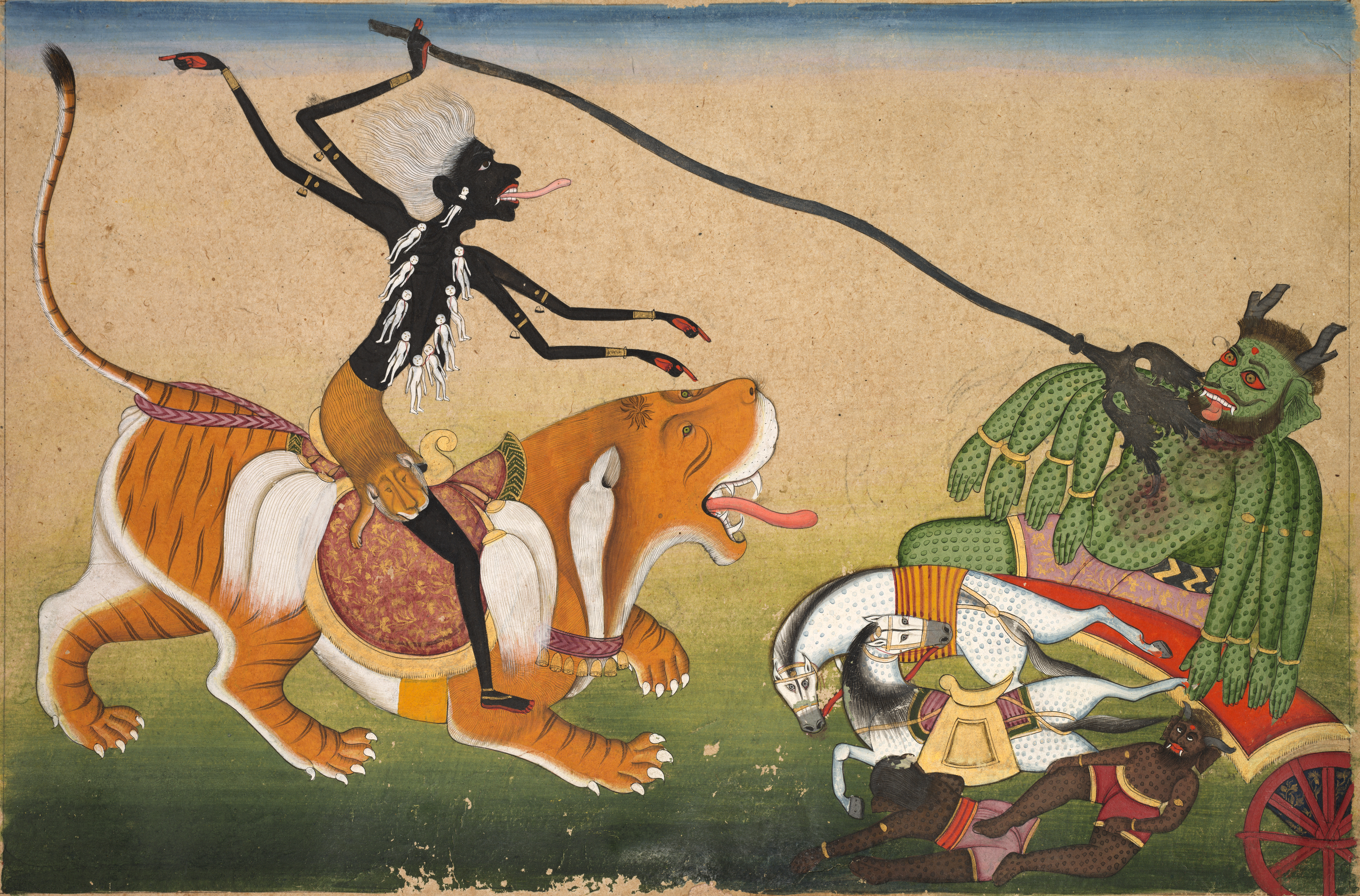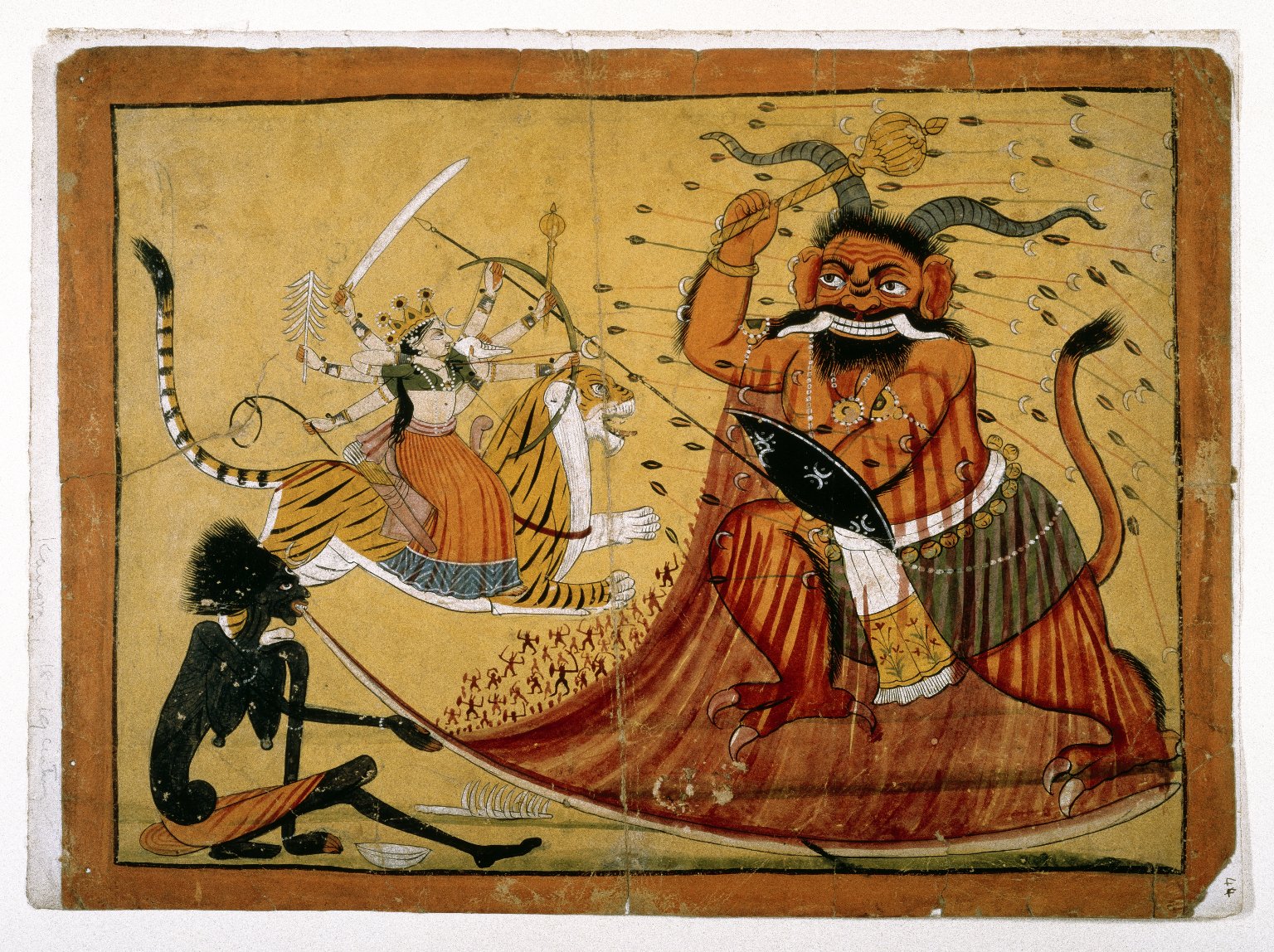|
Chanda (monster)
In Hinduism, in the Devi Mahatmya, Chanda and Munda are asuras (demons) in the service of Sumbha and Nishumbha. After the death of Dhumralochana, Sumbha sent them to fight Devi Kaushiki. After Chanda and Munda approached Devi Kaushiki, she turned black and Kali sprung from her head and killed them. Then, Kaushiki gave the name Chamunda to Kali. Afterward Raktabīja was sent, but was also slain by Goddess Kali. See also * Rambha (asura) * Raktabīja * Sumbha and Nisumbha * Mahishasura Mahishasura is a bovine asura in Hinduism. He is depicted in literature to be a deceitful demon who pursued his evil ways by shape-shifting. Mahishasura was the son of Mahisi (Buffalo) and the great-grandson of Brahmarshi Kashyapa. He was ultim ... * Dhumralochana * Sugriva (asura) References Danavas {{Hindu-myth-stub ... [...More Info...] [...Related Items...] OR: [Wikipedia] [Google] [Baidu] |
Kali Fights Demons Chanda And Munda - C
Kali (; sa, काली, ), also referred to as Mahakali, Bhadrakali, and Kalika ( sa, कालिका), is a Hindu goddess who is considered to be the goddess of ultimate power, time, destruction and change in Shaktism. In this tradition, she is considered as a ferocious form of goddess Mahadevi, the supreme of all powers, or the ultimate reality. She is the first of the ten Mahavidyas in the Hindu tantric tradition. Kali's earliest appearance is when she emerged from Shiva. She is regarded as the ultimate manifestation of Shakti, and the mother of all living beings. The goddess is stated to destroy evil in order to protect the innocent. Over time, Kali has been worshipped by devotional movements and Tàntric sects variously as the Divine Mother, Mother of the Universe, Principal energy Adi Shakti. Shakta Hindu and Tantric sects additionally worship her as the ultimate reality or ''Brahman''. She is also seen as the divine protector and the one who bestows ''moks ... [...More Info...] [...Related Items...] OR: [Wikipedia] [Google] [Baidu] |
Hinduism
Hinduism () is an Indian religion or '' dharma'', a religious and universal order or way of life by which followers abide. As a religion, it is the world's third-largest, with over 1.2–1.35 billion followers, or 15–16% of the global population, known as Hindus. The word ''Hindu'' is an exonym, and while Hinduism has been called the oldest religion in the world, many practitioners refer to their religion as '' Sanātana Dharma'' ( sa, सनातन धर्म, lit='the Eternal Dharma'), a modern usage, which refers to the idea that its origins lie beyond human history, as revealed in the Hindu texts. Another endonym is ''Vaidika dharma'', the dharma related to the Vedas. Hinduism is a diverse system of thought marked by a range of philosophies and shared concepts, rituals, cosmological systems, pilgrimage sites, and shared textual sources that discuss theology, metaphysics, mythology, Vedic yajna, yoga, agamic rituals, and temple building, among other to ... [...More Info...] [...Related Items...] OR: [Wikipedia] [Google] [Baidu] |
Devi Mahatmya
The ''Devi Mahatmya'' or ''Devi Mahatmyam'' ( sa, देवीमाहात्म्यम्, devīmāhātmyam, Glory of the Goddess) is a Hindu philosophical text describing the Goddess as the supreme power and creator of the universe. It is part of the Markandeya Purana. ''Devi Mahatmyam'' is also known as the ''Durgā Saptashatī'' () or Śata Chandī (शत् चण्डी). The text contains 700 verses arranged into 13 chapters. Along with ''Devi-Bhagavata Purana'' and Shakta Upanishads such as the Devi Upanishad, it is one of the most important texts of Shaktism (goddess) tradition within Hinduism. The ''Devi Mahatmyam'' describes a storied battle between good and evil, where the Devi manifesting as goddess Durga leads the forces of good against the demon Mahishasura—the goddess is very angry and ruthless, and the forces of good win. In peaceful prosperous times, states the text, the Devi manifests as Lakshmi, empowering creation and happiness. The verses of this ... [...More Info...] [...Related Items...] OR: [Wikipedia] [Google] [Baidu] |
Asura
Asuras (Sanskrit: असुर) are a class of beings in Indian religions, Indic religions. They are described as power-seeking clans related to the more benevolent Deva (Hinduism), Devas (also known as Suras) in Hinduism. In its Buddhism, Buddhist context, the word is sometimes translated "Titan (mythology), titan", "demigod", or "antigod". According to Hindu texts, Hindu scriptures, the asuras are in constant battle with the devas. Asuras are described in Indian texts as powerful superhuman demigods with good or bad qualities. In early Vedic literature, the good Asuras are called ''Adityas'' and are led by Varuna, while the malevolent ones are called ''Danava (Hinduism), Danavas'' and are led by Vritra. In the earliest layer of Vedic texts Agni, Indra and other gods are also called Asuras, in the sense of their being "lords" of their respective domains, knowledge and abilities. In later Vedic and post-Vedic texts, the benevolent gods are call ... [...More Info...] [...Related Items...] OR: [Wikipedia] [Google] [Baidu] |
Sumbha And Nisumbha
In the Devi Mahatmya, Sumbha (शुम्भ) and Nisumbha (निशुम्भ), were two '' asuras'' that confronted, and were ultimately slain by Kaushiki; an avatar of Devi Chandi. In the Devi Mahatmyam The story of Sumbha and Nisumbha begins in the fifth chapter of the Devi Mahatmyam. Parvati relates how two brothers of Asura stock sought to conquer the Three Worlds by subjecting themselves to severe penance and purification rituals so that no man or demon could destroy them. Sumbha and Nisumbha traveled to Pushkara, a sacred place, and remained there in prayer for ten thousand years. God Brahma saw the brothers' penance, and was pleased, granting them the boon they requested. It was at this time that Chanda and Munda, two lesser Asuras in the service of Shumbha, encountered Parvati, and were overwhelmed by her beauty. They carried reports of this goddess to Shumbha, who sought to possess Parvati and her beauty. Shumbha sent the demon Sugriva (asura) to court Parvati, b ... [...More Info...] [...Related Items...] OR: [Wikipedia] [Google] [Baidu] |
Sumbha
In the Devi Mahatmya, Sumbha (शुम्भ) and Nisumbha (निशुम्भ), were two ''asuras'' that confronted, and were ultimately slain by Kaushiki; an avatar of Devi Chandi. In the Devi Mahatmyam The story of Sumbha and Nisumbha begins in the fifth chapter of the Devi Mahatmyam. Parvati relates how two brothers of Asura stock sought to conquer the Three Worlds by subjecting themselves to severe penance and purification rituals so that no man or demon could destroy them. Sumbha and Nisumbha traveled to Pushkara, a sacred place, and remained there in prayer for ten thousand years. God Brahma saw the brothers' penance, and was pleased, granting them the boon they requested. It was at this time that Chanda and Munda, two lesser Asuras in the service of Shumbha, encountered Parvati, and were overwhelmed by her beauty. They carried reports of this goddess to Shumbha, who sought to possess Parvati and her beauty. Shumbha sent the demon Sugriva (asura) to court Parvati, but ... [...More Info...] [...Related Items...] OR: [Wikipedia] [Google] [Baidu] |
Kaushiki
Kaushiki ( sa, कौशिकी, lit=woman of the cell, translit=Kauśikī,) is a Hindu goddess, a deity who emerged from the sheath of Parvati. She was created before Parvati's conflict with the asura brothers Sumbha and Nisumbha, and was also the reason the Matrikas come into existence. According to the Lakshmi Tantra, Kaushiki is a manifestation of the goddess Lakshmi. Legends Puranas The story of Kaushiki is described in Devi Mahatmyam of Markandeya Purana. Devi Mahatmyam describes the goddess Kaushiki appearing from the sheath (or ''kosha'') of the goddess Parvati’s body when the devas sang her praises after their crushing defeat against the asuras Sumbha and Nisumbha. Their eulogies that were intended to be a plea for help caused her to manifest from Parvati's form as a fair-skinned and bright being, earning the epithet 'Gauri'. The fact that she had been created from the cells of Parvati caused her to name herself Kaushiki, literally meaning 'woman of the cell'. With th ... [...More Info...] [...Related Items...] OR: [Wikipedia] [Google] [Baidu] |
Kali
Kali (; sa, काली, ), also referred to as Mahakali, Bhadrakali, and Kalika ( sa, कालिका), is a Hinduism, Hindu goddess who is considered to be the goddess of ultimate power, time, destruction and change in Shaktism. In this tradition, she is considered as a ferocious form of goddess Mahadevi, the supreme of all powers, or the ultimate reality. She is the first of the ten Mahavidyas in the Hindu Tantras (Hinduism), tantric tradition. Kali's earliest appearance is when she emerged from Shiva. She is regarded as the ultimate manifestation of Shakti, and the mother of all living beings. The goddess is stated to destroy evil in order to protect the innocent. Over time, Kali has been worshipped by devotional movements and Tàntric sects variously as the Divine Mother, Mother of the Universe, Principal energy Adi Shakti. Shaktism, Shakta Hindu and Tantra, Tantric sects additionally worship her as the ultimate reality or ''Brahman''. She is also seen as the divi ... [...More Info...] [...Related Items...] OR: [Wikipedia] [Google] [Baidu] |
Chamunda
Chamunda (Sanskrit: चामुण्डा, ISO-15919: Cāmuṇḍā), also known as Chamundeshwari, Chamundi or Charchika, is a fearsome form of Chandi, the Hindu Divine Mother Shakti and is one of the seven Matrikas (mother goddesses).Wangu p.72 She is also one of the chief Yoginis, a group of sixty-four or eighty-one Tantric goddesses, who are attendants of the warrior goddess Parvati.Wangu p.114 The name is a combination of Chanda and Munda, two monsters whom Chamunda killed. She is closely associated with Kali, another fierce aspect of Parvati. She is identified with goddesses Parvati, Kali or Durga. The goddess is often portrayed as residing in cremation grounds or around holy fig trees. The goddess is worshipped by ritual animal sacrifices along with offerings of wine. The practice of animal sacrifices has become less common with Shaivite and Vaishnavite influences. Origins Ramakrishna Gopal Bhandarkar says that Chamunda was originally a tribal goddess, worshipp ... [...More Info...] [...Related Items...] OR: [Wikipedia] [Google] [Baidu] |
Raktabīja
Raktabija () is an asura in Hinduism. According to the Puranas, he fought with Sumbha and Nisumbha against the goddesses Kali and Chandi, both forms of Durga. Raktabija had acquired a boon from Shiva that whenever a drop of his blood fell on the ground, various Raktabijas would emerge from the spot, equivalent to his strength, form, and weapons. Legend Origin According to the Puranas, Raktabija was, in his previous birth, Rambha, the son of Danu, the king of the asuras. Due to being childless, Rambha and his brother, Karambha, performed a penance to seek offspring. The brothers performed a tapas, with Rambha seated in the midst of five fires, and Karambha in the midst of water. Alarmed, Indra assumed the form of a makara and dragged Karambha into the depths, drowning him. Enraged, Rambha decided to offer his own head to the fires as a sacrifice. Agni appeared before him, and urged him to desist from performing suicide, denouncing it as a great sin. He offered Rambha a b ... [...More Info...] [...Related Items...] OR: [Wikipedia] [Google] [Baidu] |
Rambha (asura)
Rambha is an asura in Hindu mythology. Rambha and Karambha are asura brothers, born as the descendants of Danu and Kashyapa. When they were young, both decided to perform penance to get special powers to establish the rule of Danavas in the universe. Penance and boon Rambha started penance standing inside a burning fire to please Agni Deva, while Karambha stood inside water to please Varuna Deva. When Indra became aware, he decided to kill both brothers. Firstly, Indra assumed the form of a makara and dragged Karambha into the depths, drowning him. However, Agni Deva saved Rambha when Indra tried to kill him. Finally, Rambha got a boon from Agni Deva that he would not be killed by any Deity (Deva), Demon ( Danava) or human. Only a dead man could kill him (which was virtually impossible). Rambha became powerful after getting the boon; he began mass killings of human beings and other living beings. Birth of Mahishasura Afterward, Rambha saw a water buffalo and fell in love with h ... [...More Info...] [...Related Items...] OR: [Wikipedia] [Google] [Baidu] |










